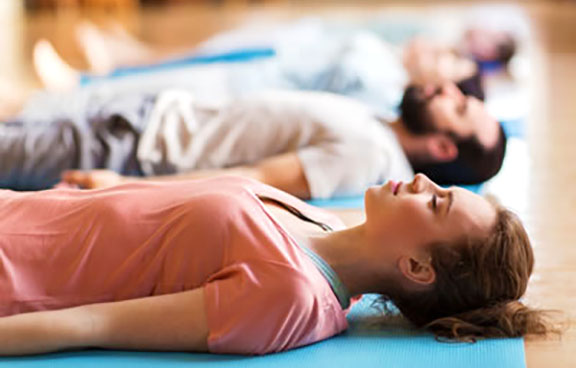 Savasana (or Corpse pose) is well-known for being the most important pose in our Yoga practice. It is the moment when all the physical hard work of class can seep into our muscles and bones, our body can melt into the floor, and we can finally do nothing but breathe. It is the asana we have been building up to for 60 minutes. Unless, of course, you can’t get comfortable. Or you can’t quiet your mind. Or you are klutzy like me, so you knock into your reusable stainless steel water bottle with your foot. The (unreasonably loud) clatter of it on the hardwood studio floor makes you lose your Zen and startles the yogi next to you. Oops.
Savasana (or Corpse pose) is well-known for being the most important pose in our Yoga practice. It is the moment when all the physical hard work of class can seep into our muscles and bones, our body can melt into the floor, and we can finally do nothing but breathe. It is the asana we have been building up to for 60 minutes. Unless, of course, you can’t get comfortable. Or you can’t quiet your mind. Or you are klutzy like me, so you knock into your reusable stainless steel water bottle with your foot. The (unreasonably loud) clatter of it on the hardwood studio floor makes you lose your Zen and startles the yogi next to you. Oops.
The laundry list of things you have to take care of after class, your errands to run, the deadlines at work begin to buzz around in your head. Your sweaty Yoga topknot is not laying right, and you fix and fidget with your hair tie. You can’t get comfortable. How many more minutes are left before class is done? The next thing you know, you have mentally left your mat, and you are back to the races with your thoughts and worries.
Staying present in stillness is not easy. Often, as the body begins to slow down, the mind begins to speed up. It feels odd and unfamiliar to do nothing. So much of the day we are running around, thinking of what is next, and multitasking. Simply being asked to do nothing, in silence, can feel overwhelming. For some, it can feel scary or even impossible. Luckily, there are some tricks to make your Savasana pose a little sweeter, easier, and more relaxing.
Here are some ways to support both your body and your mind through this pose, so that you can fully experience its powerful benefits:
Let the Low Back Release
If you have a tight low back, like much of the population who drive in our cars back and forth to work, where we sit in a desk all day, lying flat on the back is not always the most comfortable way to relax. Even after a 60-minute yoga practice, our hamstrings may not have released, and the low back may still feel tight and achy.
Rolling up a blanket and placing it underneath the knees, or using a bolster if one is available, can make a huge difference. Even if no one else is using props, I encourage you to listen to your own body and get whatever it is that can help you get comfortable! Your efforts at self-care might even inspire others to do the same.
Count your Blessings, Not your To-Dos
A daily gratitude practice is proven to benefit your mental health in the long-term; but even in the short-term, it can be a powerful thought exercise. If you are the type of yogi or yogini who starts to think about your to-do list of tasks waiting for you after class, I invite you instead to put that busy mind to work in making another list: a list of things that you are grateful for that day.
Grateful that you have the space in your schedule to get to a Yoga class? The financial means to pay for a class? The car (or legs, if you walked!) that takes you to and from the studio? The water you drank? The arms and legs that carried you through your flow? The lungs that breathed as you practiced?
Simply shifting your focus to the specific little things you are grateful for can be beneficial for your Savasana.
It’s All in the Eyes
Take extra care of your eyes in Savasana. All day we are so visually stimulated. Whether it is by ads that we consume on billboards or television commercials, signs we pass while driving, screens that we work on, our eyes are tired! We are constantly receiving input.
Giving your eyes a few tangible cues that they can relax for a few minutes can go a long way. If you remember, you can bring an eye pillow or eye mask to class at your studio. It’s not self-indulgent; it’s self-care!
If you are practicing at a gym, grab an extra towel from the locker room and bring it into class. Fold it up a few times and place it over your eyes for Savasana. Or, if you are like me and tend to be lucky if you even remember to bring your own mat to class, let alone any extras, just keep it simple. Rub your hands together to bring some heat or prana flow in between your palms. Then, gently place your hands over your eyes and feel your eyelids soften and your eyeballs relax into their sockets. Feel the space between your brow relax. Take a breath or two there, before releasing your hands back down to your sides.
Bring an Extra Layer
Your body temperature naturally goes down in Savasana pose….Try to remember to pack a long-sleeve shirt or hoodie to slip on at the end of class. It’s hard to relax if you are not warm enough!
Most Importantly
Do not skip it! I get it, we are all rushed. Our days are overscheduled, our lives are busy, traffic is rough. Sixty minutes to a class is a commitment that we don’t always have the luxury of. Personally, I believe that some Yoga is better than no Yoga, so if you can only have 50 minutes of a 60-minute time slot…as a teacher, I say, go for it!
But, even if you are particularly rushed that day, and, gasp, need to leave class early, you can still find time for the most important pose in your practice. Let your instructor know in the beginning of the class that you have to leave a few minutes early. Make sure to place your mat near the back of the class and close to the door.
Then, about five minutes or so before you have to roll up your mat, begin to wind yourself down on your own. And then take your Savasana early. When you do have to leave, quietly roll up your mat and mindfully walk out without disturbing others who are resting.
Handstands look pretty on the beach. Backbends get likes on Instagram. But Savasana is where the studio class ends and the truest Yoga begins.
Remember that you are a human being, and not a human doing. Lie still, and trust that the lying still is enough.
 About the Author:
About the Author:
Logan Kinney is a Yoga teacher, stand up paddle board yoga teacher, massage therapist, and mama. She teaches locally, at Yoga retreats, or can bring Yoga and massage to the space of your choice. She loves being in the water, a good green smoothie, and an adventure. Although her passion is supporting others through their health and wellness journeys, her favorite job is being a mama.
Article reprinted from Elephant Journal

